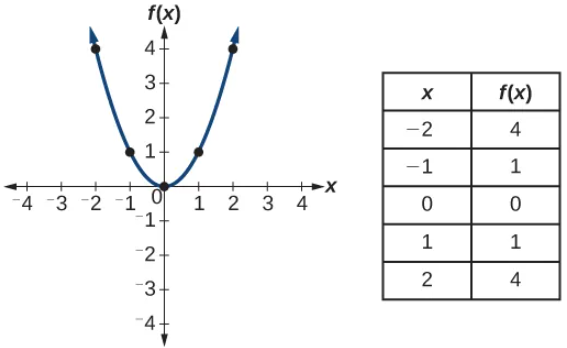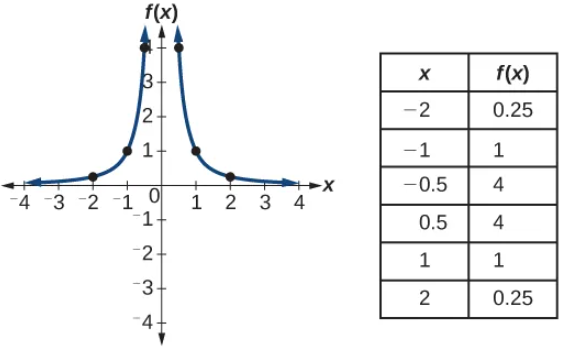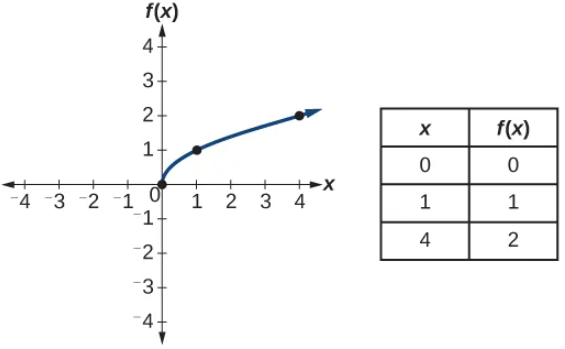Transformations of Functions
Understanding how to transform the graph of a function is essential in visualizing mathematical concepts. Transformations include shifting, stretching, or reflecting the graph. Shifting moves the graph up, down, left, or right, stretching alters its width or height, and reflecting flips it over an axis.
Vertical Shift
Vertical shifts in graphs occur when each point on the graph moves up or down by the same amount. This shift is the result of adding or subtracting a constant to the function’s output value [latex]y[/latex].
For a positive constant [latex]c[/latex], adding it to a function [latex]f(x)[/latex] results in [latex]f(x)+c[/latex], raising the graph up [latex]c[/latex] units. Conversely, subtracting [latex]c[/latex] from [latex]f(x)[/latex] to get [latex]f(x)-c[/latex] lowers the graph by [latex]c[/latex] units. These shifts do not affect the shape of the graph; they simply reposition it along the [latex]y[/latex]-axis.
vertical shift
Vertical shifts do not alter the shape of a function’s graph, only its position along the [latex]y[/latex]-axis. Adding a positive constant lifts the graph upwards, while subtracting it pushes the graph downwards.
The graph of the function [latex]f(x)=x^3+4[/latex] is the graph of [latex]y=x^3[/latex] shifted up 4 units; the graph of the function [latex]f(x)=x^3-4[/latex] is the graph of [latex]y=x^3[/latex] shifted down [latex]4[/latex] units (Figure 15).

Horizontal Shift
Horizontal shifts in function graphs reflect the influence of adding or subtracting a constant from each input value [latex]x[/latex].
For a positive constant [latex]c[/latex], subtracting it from [latex]x[/latex] to form [latex]f(x-c)[/latex] shifts the graph to the right by [latex]c[/latex] units. In contrast, adding [latex]c[/latex] to [latex]x[/latex], resulting in [latex]f(x+c)[/latex], moves the graph to the left by [latex]c[/latex] units.
horizontal shift
Horizontal shifts alter the position of a function’s graph along the [latex]x[/latex]-axis but do not change its shape. Subtracting a positive constant from the input moves the graph to the right, while adding it shifts the graph to the left
Why does the graph shift left when adding a constant and shift right when subtracting a constant? To answer this question, let’s look at an example.
Consider the function [latex]f(x)=|x+3|[/latex] and evaluate this function at [latex]x-3.[/latex] Since [latex]f(x-3)=|x|[/latex] and [latex]x-3 < x[/latex], the graph of [latex]f(x)=|x+3|[/latex] is the graph of [latex]y=|x|[/latex] shifted left [latex]3[/latex] units. Similarly, the graph of [latex]f(x)=|x-3|[/latex] is the graph of [latex]y=|x|[/latex] shifted right [latex]3[/latex] units (Figure 16).

Vertical Scaling (Stretched/Compressed)
A vertical scaling of a graph occurs if we multiply all outputs [latex]y[/latex] of a function by the same positive constant [latex]c[/latex].
If [latex]c>1[/latex], the graph of the function [latex]cf(x)[/latex] appears vertically stretched, as the outputs are proportionally larger than those of the original function [latex]f(x)[/latex]. If [latex]0 < c <1[/latex], then the outputs of the function [latex]cf(x)[/latex] are smaller, so the graph has been compressed, resulting in a graph that is closer to the [latex]x[/latex]-axis.
vertical scaling
Vertical scaling changes the steepness of a function’s graph. Multiplying by a constant greater than [latex]1[/latex] stretches the graph away from the [latex]x[/latex]-axis, while multiplying by a constant between [latex]0[/latex] and [latex]1[/latex] compresses it towards the [latex]x[/latex]-axis.
The graph of the function [latex]f(x)=3x^2[/latex] is the graph of [latex]y=x^2[/latex] stretched vertically by a factor of [latex]3[/latex], whereas the graph of [latex]f(x)=\frac{x^2}{3}[/latex] is the graph of [latex]y=x^2[/latex] compressed vertically by a factor of [latex]3[/latex] (Figure 17).

Horizontal Scaling (Stretched/Compressed)
Horizontal scaling modifies the width of a function’s graph by stretching or compressing it along the [latex]x[/latex]-axis. This effect is achieved by multiplying the input, [latex]x[/latex], by a constant [latex]c[/latex].
When [latex]c>0[/latex], the function [latex]f(cx)[/latex] is the graph of [latex]f(x)[/latex] is compressed, as each input value is effectively scaled down, bringing the points closer together horizontally. If [latex]0 < c <1[/latex], the function [latex]f(cx)[/latex] is stretched, because the input values are scaled up, spreading the points further apart on the [latex]x[/latex]-axis.
horizontal scaling
Horizontal scaling affects the horizontal spread of a function’s graph. Multiplying the input by a constant greater than [latex]1[/latex] compresses the graph, while a constant between [latex]0[/latex] and [latex]1[/latex] stretches it.
Consider the function [latex]f(x)=\sqrt{2x}[/latex] and evaluate [latex]f[/latex] at [latex]\dfrac{x}{2}.[/latex] Since [latex]f(\frac{x}{2})=\sqrt{x}[/latex], the graph of [latex]f(x)=\sqrt{2x}[/latex] is the graph of [latex]y=\sqrt{x}[/latex] compressed horizontally. The graph of [latex]y=\sqrt{\frac{x}{2}}[/latex] is a horizontal stretch of the graph of [latex]y=\sqrt{x}[/latex] (Figure 18).

Reflection
Reflections of a function’s graph across an axis create a mirror image. When we multiply the outputs of a function, [latex]f(x)[/latex], by [latex]-1[/latex] we achieve a reflection across the [latex]x[/latex]-axis, turning every point to its opposite position vertically. Similarly, multiplying the inputs by [latex]-1[/latex] before applying the function, as in [latex]f(-x)[/latex], reflects the graph across the y-axis, flipping it horizontally.
reflections of functions
Reflecting a function’s graph across an axis is accomplished by multiplying by[latex]-1[/latex]. To mirror across the [latex]x[/latex]-axis, multiply the outputs by [latex]-1[/latex]. To reflect across the [latex]y[/latex]-axis, multiply the inputs by [latex]-1[/latex].
The graph of [latex]f(x)=−(x^3+1)[/latex] is the graph of [latex]y=(x^3+1)[/latex] reflected about the [latex]x[/latex]-axis. The graph of [latex]f(x)=(−x)^3+1[/latex] is the graph of [latex]y=x^3+1[/latex] reflected about the [latex]y[/latex]-axis (Figure 19).

Multiple Transformations
If the graph of a function consists of more than one transformation of another graph, it is important to transform the graph in the correct order. Given a function [latex]f(x)[/latex], the graph of the related function [latex]y=cf(a(x+b))+d[/latex] can be obtained from the graph of [latex]y=f(x)[/latex] by performing the transformations in the following order.
- Horizontal shift of the graph of [latex]y=f(x)[/latex]. If [latex]b>0[/latex], shift left. If [latex]b<0[/latex], shift right.
- Horizontal scaling of the graph of [latex]y=f(x+b)[/latex] by a factor of [latex]|a|[/latex]. If [latex]a<0[/latex], reflect the graph about the [latex]y[/latex]-axis.
- Vertical scaling of the graph of [latex]y=f(a(x+b))[/latex] by a factor of [latex]|c|[/latex]. If [latex]c<0[/latex], reflect the graph about the [latex]x[/latex]-axis.
- Vertical shift of the graph of [latex]y=cf(a(x+b))[/latex]. If [latex]d>0[/latex], shift up. If [latex]d<0[/latex], shift down.
We can summarize the different transformations and their related effects on the graph of a function in the following table.
| Transformation of [latex]f(c>0)[/latex] | Effect on the graph of[latex]f[/latex] |
|---|---|
| [latex]f(x)+c[/latex] | Vertical shift up [latex]c[/latex] units |
| [latex]f(x)-c[/latex] | Vertical shift down [latex]c[/latex] units |
| [latex]f(x+c)[/latex] | Shift left by [latex]c[/latex] units |
| [latex]f(x-c)[/latex] | Shift right by [latex]c[/latex] units |
| [latex]cf(x)[/latex] | Vertical stretch if [latex]c>1[/latex]; vertical compression if [latex]0 < c < 1[/latex] |
| [latex]f(cx)[/latex] | Horizontal stretch if [latex]0 < c < 1[/latex]; horizontal compression if [latex]c>1[/latex] |
| [latex]−f(x)[/latex] | Reflection about the [latex]x[/latex]-axis |
| [latex]f(−x)[/latex] | Reflection about the [latex]y[/latex]-axis |
Describe how the function [latex]f(x)=−(x+1)^2-4[/latex] can be graphed using the graph of [latex]y=x^2[/latex] and a sequence of transformations.
It is beneficial when working with transformations to remember the basic toolkit functions. These will be your starting points when trying to identify how the function has been transformed.
For each of the following functions, sketch a graph by using a sequence of transformations of a toolkit function.
- [latex]f(x)=−|x+2|-3[/latex]
- [latex]f(x)=3\sqrt{−x}+1[/latex]










